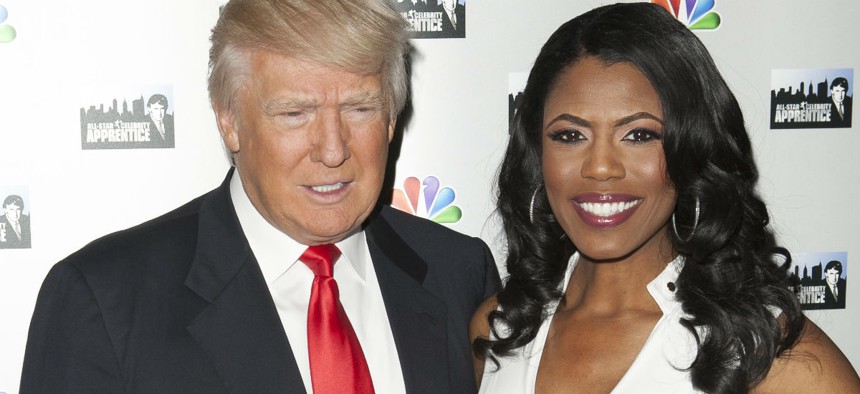Omarosa’s Recordings Show the Problem with Honor-System Security

Donald Trump and Omarosa Manigault attend the 'All-Star Celebrity Apprentice' Red Carpet Event at Trump Tower on April 1, 2013 in New York City. Diego Corredor/MediaPunch/IPx
The White House relies on employees to turn over any devices prior to entering a secured room but has few fail-safes if they don’t.
While the Trump administration fights back against another former adviser with taped conversations with the president, security-minded White House-watchers are more concerned about the tapes themselves than any content they might hold.
As former presidential adviser Omarosa Manigault Newman pushes her new tell-all about her time in the White House, she revealed the existence of several recordings of conversations between herself, President Trump and his staff.
During an interview with Chuck Todd on Sunday’s “Meet the Press,” Manigault released the audio of her firing by Chief of Staff John Kelly, a discussion that Manigault said took place in the Situation Room, the name for a set of three highly-secured conference rooms in the White House used for discussions with national security implications.
The Situation Room is a sensitive compartmented information facility, or SCIF, which means it is secured from outside surveillance and prevents transmission of data in or out of the room. However, most SCIFs do not jam or otherwise prevent recording equipment from working inside the room, according to guidance from the Office of the Director of National Intelligence. That includes the Situation Room, according to former White House officials.
The DNI guidance prohibits any electronic devices from entering a SCIF without express approval in the form of a waiver, even those classified as low-risk devices like calculators or receive-only pagers. High-risk devices such as smartphones are to be completely restricted unless additional technical measures are put in place that reduce the risk to low.
“These rules apply to SCIFs around the military, law enforcement and departments and agencies … to ensure that when our enemies or spies compromise a device, they can't just wait for it to enter a SCIF and then listen in, watch or record classified conversations,” said Theresa Payton, who served as White House chief information officer under President George W. Bush and is now CEO of Fortalice Solutions.
When Ari Schwartz worked in the White House as senior director for cybersecurity for the National Security Council from March 2014 to October 2015, it was made clear that no phones or other electronic devices were allowed in the Situation Room or other sensitive areas, like the Cabinet Room and Roosevelt Room.
“When you do your security clearance, they make it very clear to people that the policy is you don’t bring your phone into a SCIF,” he said.
Staff sits outside the Situation Room door to instruct people to leave their phones and other devices in a locked cabinet outside. But there is no metal detector, nor screening process to ensure people are following the rules—just an honor system, several former officials told Nextgov.
“We had a few situations where people familiar with how it works in the Situation Room would come in and take out their phone and everyone at the table would say, ‘No, you’ve got to put that away,’” said Schwartz, who currently serves as managing director of cybersecurity services at Venable. “If you repeatedly did that, that’s a fireable offense.”
When it comes to Manigault’s story—in which she admits to recording the president and his staff multiple times in secure locations—the offense is that much greater.
“This is serious and a matter of national security,” said Payton. “If what she reports to have happened is true, the fact that she dismissed prominent signage prohibiting devices is disappointing at best.”
There aren’t too many technical solutions available, Payton said, as anything that could jam a recording device would cause problems for the legitimate technology in use in the room.
“White noise devices and other technology could prevent audio recordings but they could also potentially interfere with the approved devices installed to conduct the nation's business and or make it hard for secure calls and secure video conference participants to hear each other and degrade audio quality,” she said.
And as for scanning people entering the Situation Room, there’s little anyone could do to stop a motivated person from concealing a recording device, Schwartz said.
“They make very, very small recording devices now that are not necessarily made of metal,” he said, making them difficult to detect. “If someone really wanted to record, it would be easy for them to do so.”



